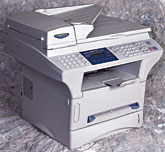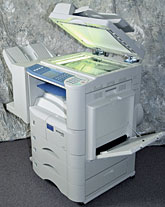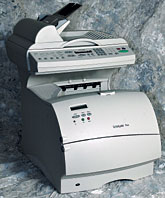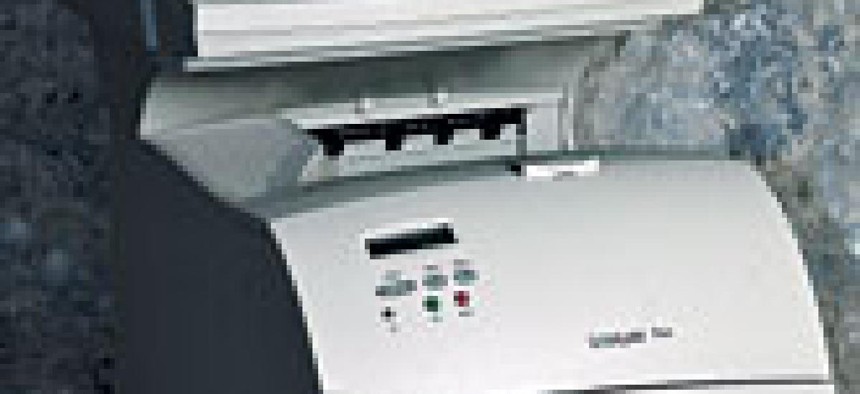The GCN Lab's call for midsized print/scan/copy devices suitable for government offices drew several impressive machines. Some were small enough for the average desk. Others were the size of a small refrigerator.Any good multifunction device gives office workers a single place to go for all their paper needs. Printing, faxing, scanning, copying and even digital sending of documents should all occur at one convenient location, because workers often do several related tasks at once'for example, printing out a document to fax it.Also, a multifunction device should work at least as fast as a standalone unit. Nobody wants to stand around waiting to make a copy while someone else prints out a 500-page report at 10 pages per minute.Furthermore, all the components should be high-quality. It's foolish to marry a great printer to a shoddy fax machine. Early multifunction devices had a lot of problems in this area. Pioneering vendors cobbled together a hodgepodge of ribbon cables, screws and mounting brackets into Rube Goldberg devices. The interdevice communication was far from reliable.Today, most multifuction devices are designed from the ground up as one unit that can't be taken apart. Some have components that share the same print engine and software logic so that they're truly unified.A big advantage to purchasing a multifunction peripheral is price. The savings won't be huge, but you should pay substantially less than for separate peripherals.The GCN Lab tested four multifunction devices, awarding bonus points for features such as easy accessibility and advanced user controls. All the units in the review could connect to a LAN.[IMGCAP(1)]The $799 Brother Industries could fax, scan, copy, print and send PC faxes. Its blue Brother emblem reminded us of our school nights writing term papers on a Brother word processor.Brother products were solid performers back then and still are. The MFC9800 earned our Reviewer's Choice and Bang for the Buck designations for high quality at low cost.The copies and faxes were the sharpest and clearest in this review. The machine felt solid, from its 250-sheet tray to its flatbed scanner.In speed, the MFC9800 was average at printing and copying, turning out about 15 ppm. It picked up velocity at faxing and scanning, and its 33.6-Kbps modem took nine minutes to fax 50 pages of text and pictures. The fax tray held up to 50 pages.Scanning 50 pages into the 8M of memory took 2 minutes, 30 seconds'faster than the more expensive Panasonic model described below. Faxing data stored in the 8M of onboard memory, which held around 600 pages, took 6 minutes, 30 seconds. The MFC9800 had 4M more memory than the Xerox unit described below and could accept up to 40M.The MFC9800's scanning component captured color information, but unfortunately that was the only color feature. Printing was monochrome only, and the toner needed changing about every 6,000 pages.Even though printing was only in black and white, we could churn out up to 99 copies at a time at 600 dots per inch.The PC fax software was both Microsoft Windows- and Mac OS-compatible.In addition to the Brother's great price, quality and speed, it had a very small footprint. At 33 pounds, it was among the lightest multifunction devices we have seen. Placing the MFC9800 in the center of the office where everyone can reach it would be easy.[IMGCAP(3)]Panasonic's in contrast weighed 114 pounds and rolled around on four wheels. If you buy it, a technician will come to set it up.Once up and running, the WORKiO was a solid performer and earned another Reviewer's Choice as a network printer, fax and Internet fax machine. As you would expect of a large unit, speed was impressive. It could scan a 50-page document in just 2 minutes, 40 seconds, and it began faxing that document just 26 seconds into the scan.Although total transmission time depends as much on the receiving fax machine as the sending one, you can be sure of picking up your papers and walking away in less than 3 minutes. In our tests the WORKiO DP-3000E sent one fax page every 3 seconds. That's fast.The copying and network printer features also were impressive. Even very lightly shaded shapes on test images were distinguishable. The WORKiO could staple and sort documents in a variety of helpful ways after turning them out at 33 ppm.One big advantage of the WORKiO was accessibility to disabled users. The control panel was at an easy height for someone in a wheelchair. Two 550-sheet paper trays could be removed to lower the unit even more if needed, taking the overall height down to just 27 inches.The control panel had a logical layout with large, raised buttons a visually challenged user could distinguish. Phone pad buttons were large and readable, and they had texture and plenty of space between them. The main LCD panel's controls were adjustable for maximum readability.The WORKiO DP-3000E would be a great choice for an office with disabled workers, besides being all-around fast and impressive. It could comfortably serve a workgroup of say, 20 to 25, and at $8,645, it would be worth the cost.The Xerox was a solidly built digital copier, color scanner, laser printer and fax. In tests it was speedy, though not nearly as fast as the Brother, whose desktop form factor it shared.[IMGCAP(2)]The WorkCentre Pro 412 scanned our 50-page test document in 5 minutes, 10 seconds and faxed it in 6 minutes, 35 seconds, adding up to a total 11 minutes, 45 seconds to fax a 50-document. The send time was nearly identical to the Brother unit's; they both had a 33.6-Kbps fax modem.Slower scanning time put the 412 behind the Brother in our overall rating.The WorkCentre Pro 412's output quality was not as impressive as the Brother's, though it came close. Copied documents looked crisp with only a few notable exceptions for white text on a black background.The WorkCentre printed 12 ppm, which put it last in terms of raw speed.But despite its flaws, it had design features to increase productivity. For example, the pause-printing button on the main console would save time for a worker who needs a quick copy and doesn't have time to wait for someone else's 100-page report creeping along at 12 ppm. The user could press the pause button, take care of business and then let the device resume the large job.The Xerox was the only unit in the review with a color fax function. It couldn't print in color, but it could scan color documents and put the color images on a network.A color document scanned into the fax function would print in color at the other end'if a color fax machine were there to receive it. Assuming the color fax trend catches on, Xerox is going to be ahead of everybody else.The WorkCentre Pro 412 would be appropriate for small workgroups or as a superior personal printer. But expect congestion if more than about 10 people share the device. It requires a $175 Ethernet card for network operation.The Lexmark International multifunction device had noticeably lower print quality than the other devices in the review. Its copies and received faxes were blurry and difficult to read.[IMGCAP(4)]To get good printouts, we had to turn the resolution up to super-fine or ultra-fine, which lengthened print time.The Lexmark X520 was the only multifunction unit in the review that was essentially a printer (Lexmark's T520) with a flatbed scanner add-on. It's up to the user to assemble and connect the flatbed to the printer via provided SCSI cables.Assembly took us only about 10 minutes. But the 17.5- by 14- by 13-inch flatbed, connected by two screws, hung awkwardly over the printer. It could easily tip backward if the scanner lid were flipped open hard. And it wobbled in use, even with tight mounting screws.Although the X520 was the second-fastest printer in the review, averaging close to 20 ppm, it scanned more slowly. It could scan and fax multiple documents at the same time, unlike the Xerox and Brother units, which scanned first and then sent.The problem we encountered was that the Lexmark X520 can't fax more than 25 pages at a time.We found nothing in the documentation about the 25-page limit but finally learned about it after many calls to the vendor to troubleshoot the poor test results.GCN used public relations channels and not the company help line to attempt to troubleshoot this problem.It took us four tries to fax a large document successfully from the Lexmark. The failed attempts kept registering busy signals, even though the receiving fax machine a few feet away on the lab network wasn't in use. There was no problem sending a single-page fax to the same machine.Any user in this situation would incorrectly conclude from the erroneous busy signals that something was wrong with the receiving fax machine.After a few experiments, we did succeed at scanning and sending a 50-page document, contrary to what the company had told us about the 25-page limit. It's possible to send up to 60 pages in one swoop, but only if the paper is fed in 25-page increments.Using that workaround, we were able to conduct our comparative speed tests. The Lexmark scanned and sent the test document in 5 minutes, 43 seconds.It boasted a generous 40M of memory, upgradeable to 264M. Too bad that much memory can't deliver more fax pages, because the other units in this review with a lot less memory sent a lot more pages.The Lexmark came with a standard 250-page tray and toner that lasted for about 5,000 pages. It would be worth its $2,000 price tag except for the poor print quality and the annoying 25-page limit on faxes, which limits its usefulness for large workgroups.At last year's Comdex computer trade show, we saw three other Lexmark multifunction devices that were faster and had color. Lexmark chose not to submit any of them for this review, which we regret because all three at the show performed far better than the X520.Two other multifunction devices, the Hewlett-Packard LaserJet 1200 and the Toshiba eStudio45, were submitted but left out for technical reasons.The LaserJet 1200 did not come with a peripheral to connect to a network. The eStudio45, which requires factory technicians to assemble it, was not ready in time for our testing deadline. Both units may appear as standalone reviews in future issues of GCN.
Brother Industries MFC9800
Panasonic's WORKiO DP-000E
Lexmark International X520







